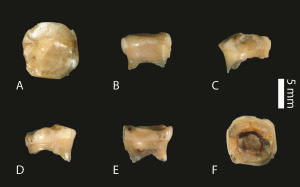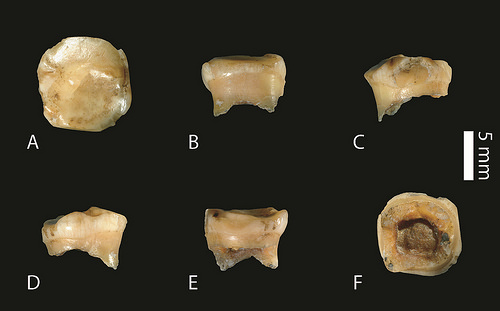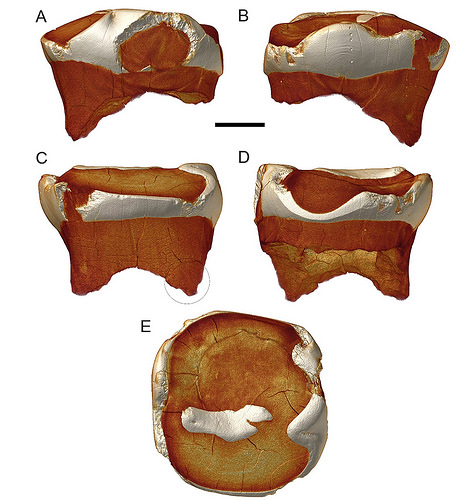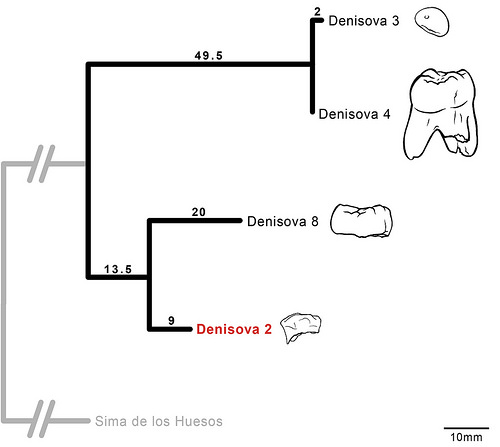
Scientists studying a newly discovered molar from the Denisova Cave in Siberia estimate the tooth is at least 20,000 years older than previously examined Denisovan fossils. The finding has important implications for understanding hominin evolution and adds to the “meager Denisovan fossil record,” of just three other Denisovan individuals, the authors say. What’s more, the molar provides evidence that Denisovans were present for a longer time in the region, allowing for more potential mingling between Neanderthals and Denisovans. The poor preservation of the molar was a challenge for Viviane Slon, Svante Pääbo, and colleagues as they analyzed the tooth. Nonetheless, they were able to extract DNA and compare the sequence to other Denisovan samples, as well as Neanderthal and human DNA. Results suggested that the female owner of the deciduous tooth, or “baby tooth,” lived at least 100,000 years ago. This age would make the tooth one of the oldest hominin remains discovered in Central Asia to date. The DNA found in the tooth is consistent with low levels of diversity among DNA from all the Denisovan samples recovered from the cave, the authors say, comparable to the lower range of genetic diversity in modern human populations. It’s possible, however, the samples from the cave represent an isolated population and that the genetic diversity of Denisovans across their geographical range was greater. Additional Denisovan fossils from other locations are needed to more comprehensively gauge their genetic diversity, the authors add.
___________________________________
Photographs of the Denisova 2 lower second molar in (A) occlusal, (B) mesial, (C) buccal, (D) lingual, (E) distal, and (F) apical views. Scientists estimate the molar found in the Denisova Cave in Siberia is older than previously studied Denisovan fossils. Credit: Slon et al. Sci. Adv. 2017; 3: e1700186
______________________________________________
Photographs of the Denisova 2 lower second molar in (A) occlusal, (B) mesial, (C) buccal, (D) lingual, (E) distal, and (F) apical views. The scale for all panels is 2.5 millimeters. The area sampled for ancient DNA analyses is marked by a gray circle in panel C. Credit: Slon et al. Sci. Adv. 2017; 3: e1700186
_______________________________________________
Phylogenetic tree relating the Denisova 2 mitochondrial DNA with other Denisovan mitochondrial DNA sequences. The mitochondrial DNA from Sima de los Huesos was used as an outgroup. The schematic representations of the specimens are drawn to scale, shown in the lower right corner. Credit: Slon et al. Sci. Adv. 2017; 3: e1700186
______________________________________________
Science Advances is published by AAAS, the nonprofit science society.
Article Source: News release of the AAAS
_______________________________________________
Receive 30 days free access to the popular new CuriosityStream lineup of documentaries on science, history, nature, and technology as a new Popular Archaeology premium subscriber.
___________________________________________
Travel and learn with Far Horizons.
____________________________________________
This richly illustrated issue includes the following stories: Recent findings shedding new light on the whereabouts of the remains of Philip of Macedon, father of Alexander the Great; how an archaeologist-sculptor is bringing bones of the dead back to life; archaeologists uncovering town life at the dawn of civilization; an exclusive interview with internationally acclaimed archaeologist James M. Adovasio about what makes the Meadowcroft Rockshelter prominent in the ongoing search for the first Americans; what archaeologists are finding at the site of the ancient city of Gath, the home town of the biblical Philistine giant, Goliath; and how scientists are redrawing the picture of human evolution in Europe. Find it on Amazon.com.










